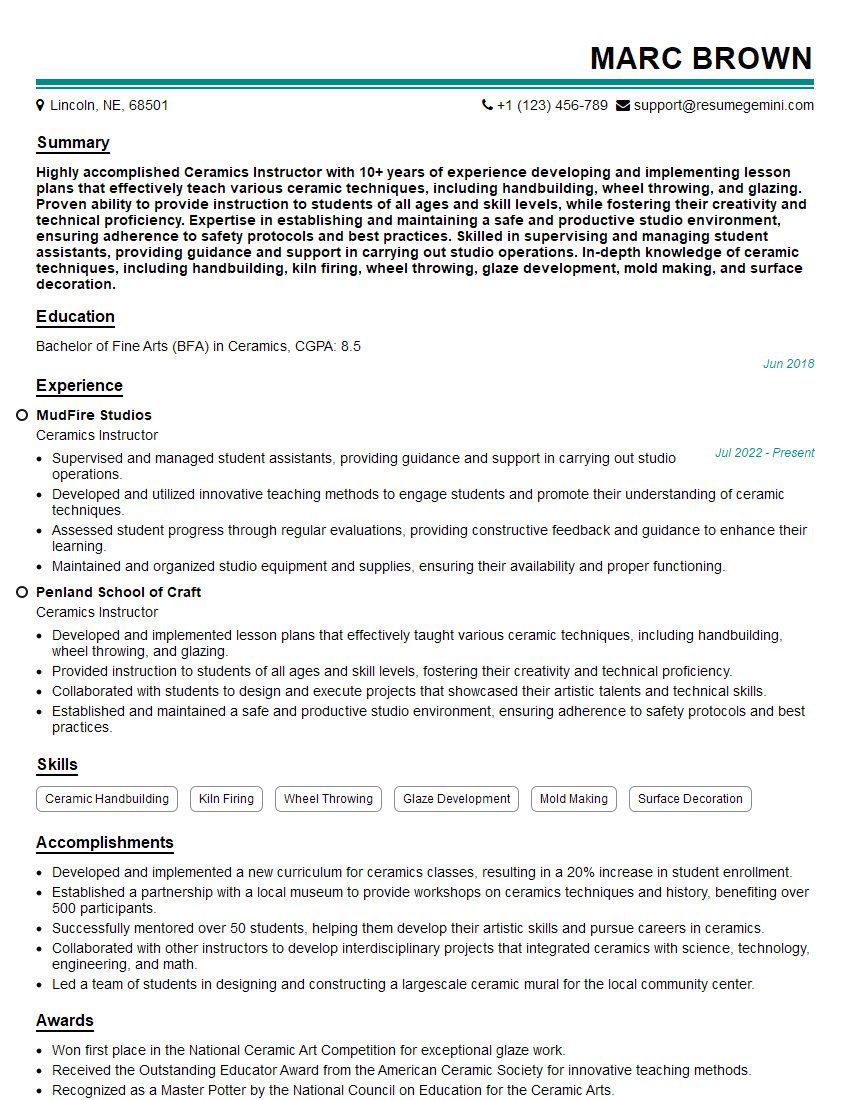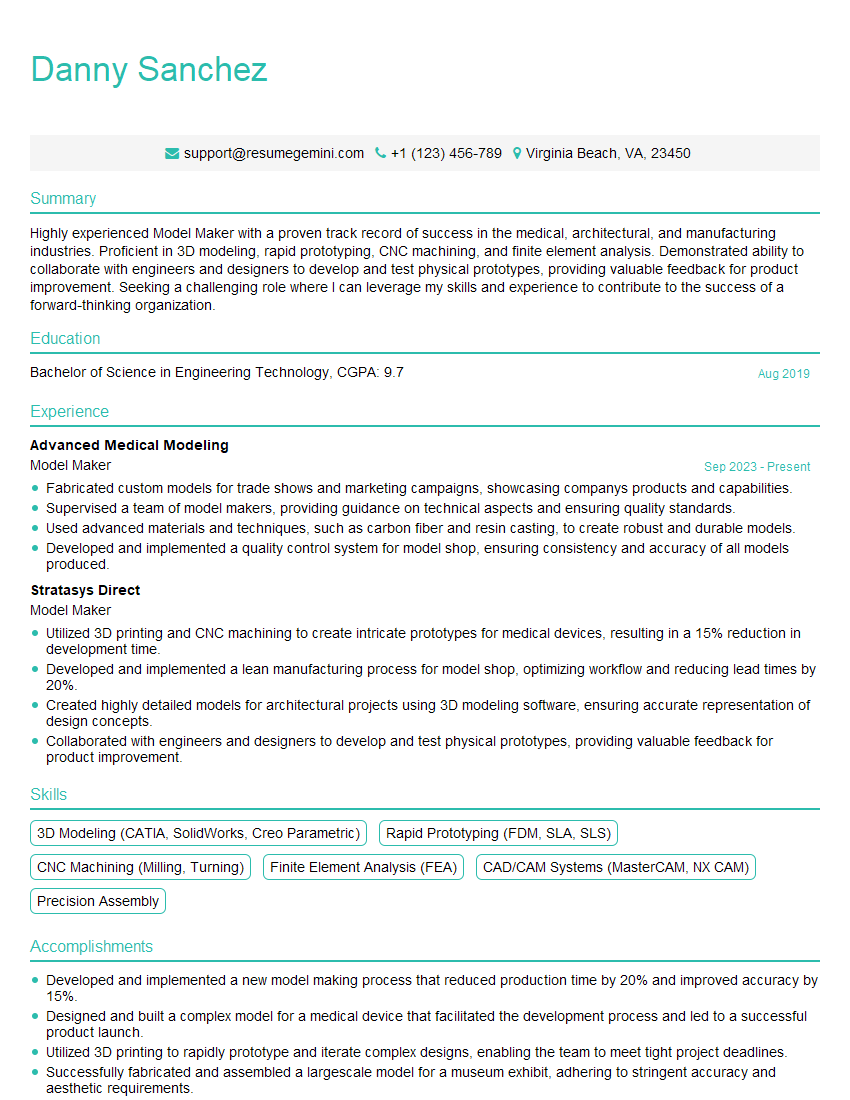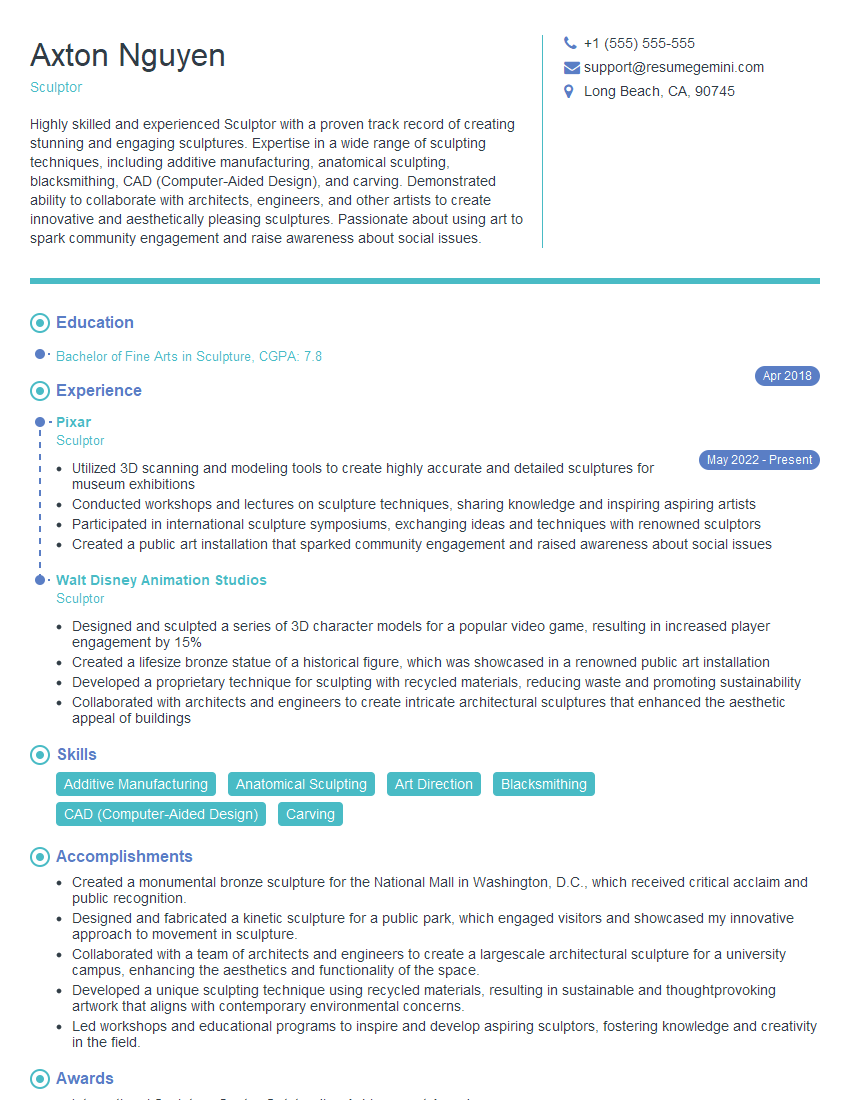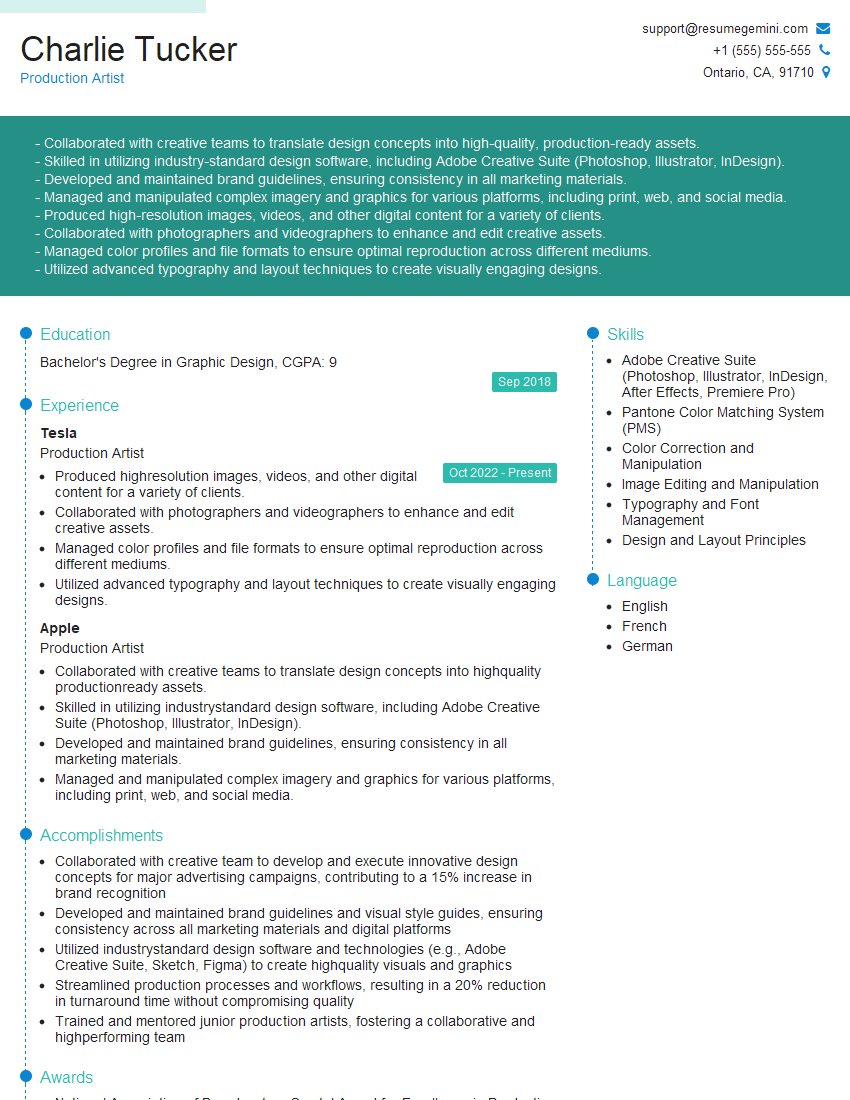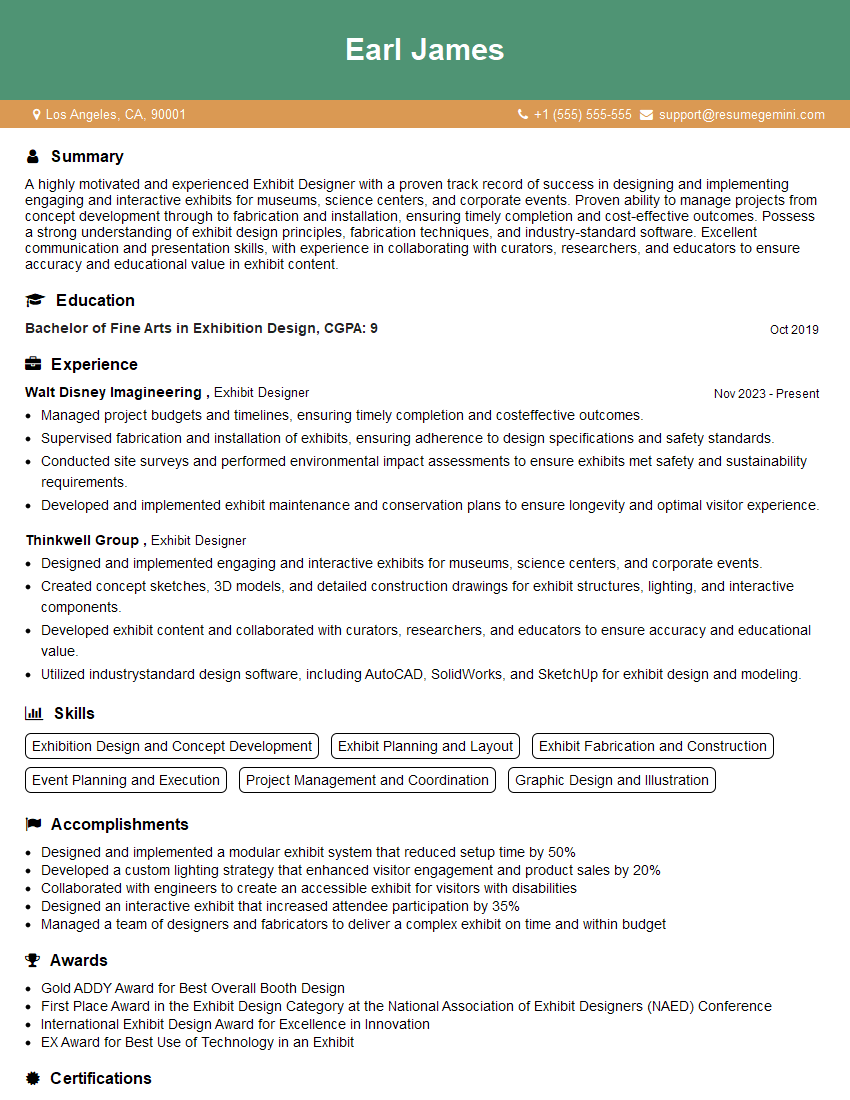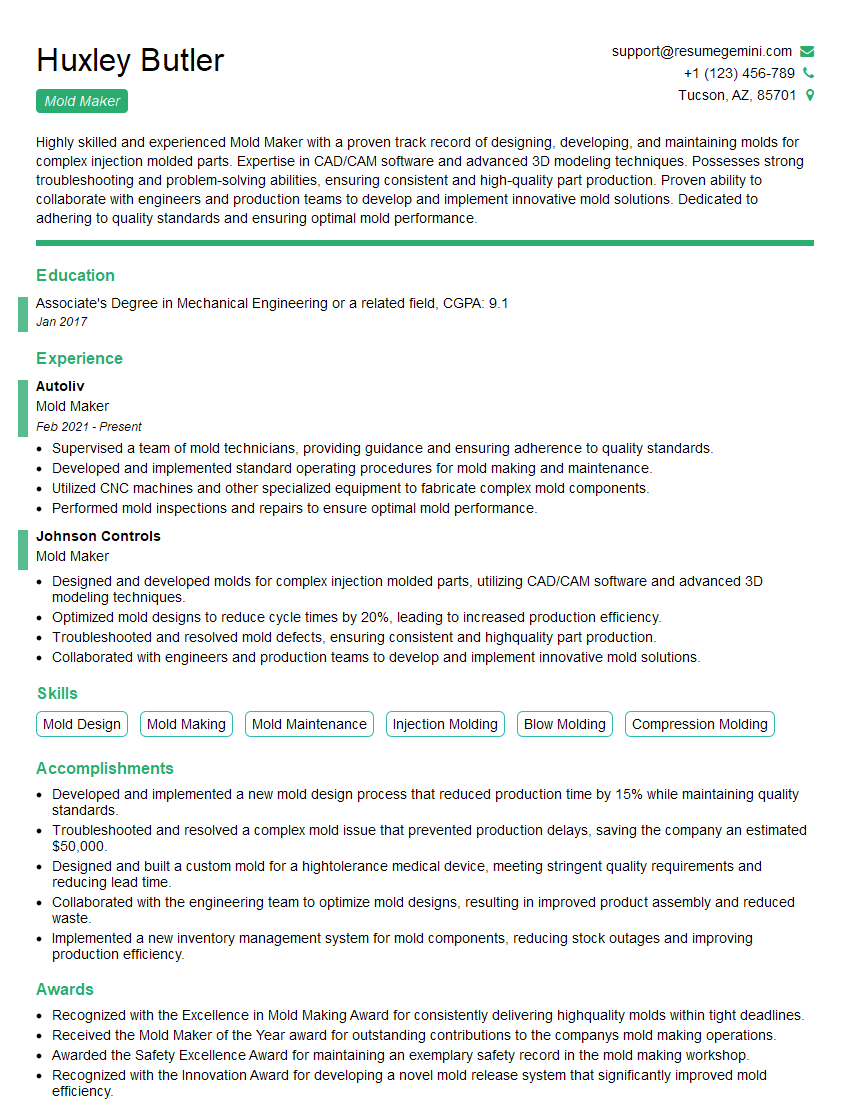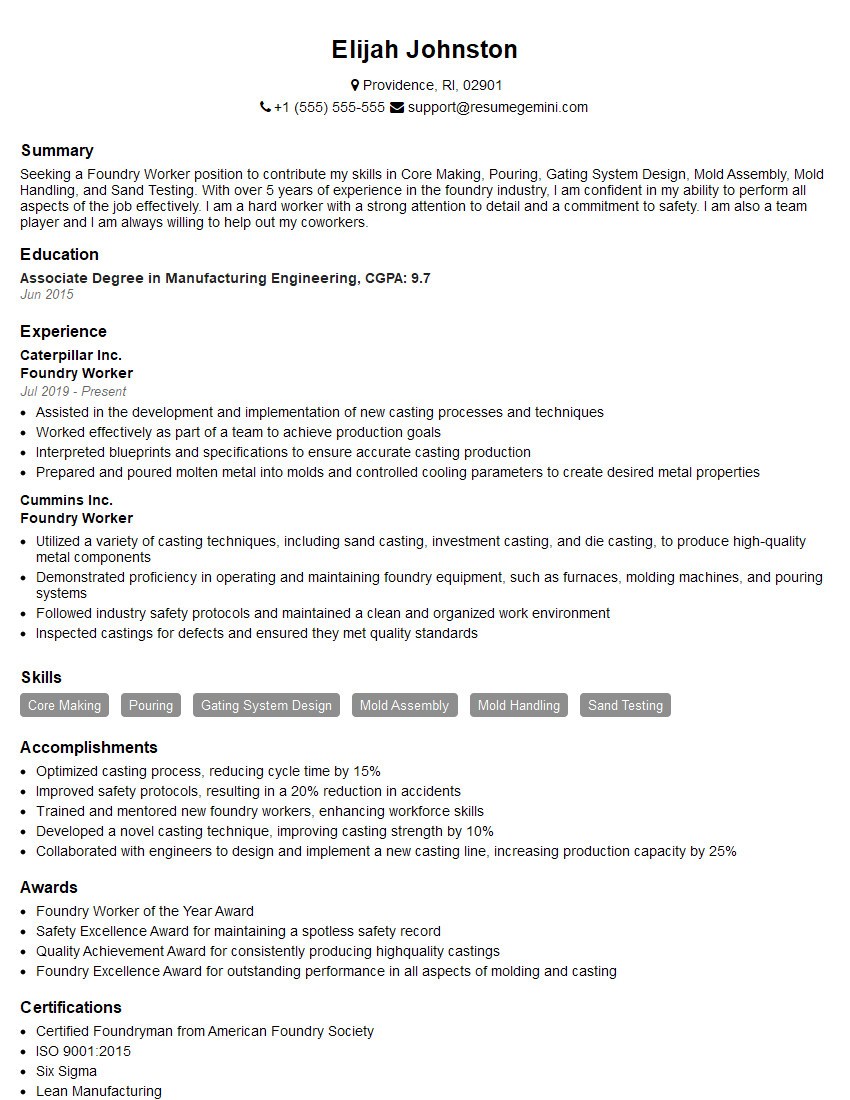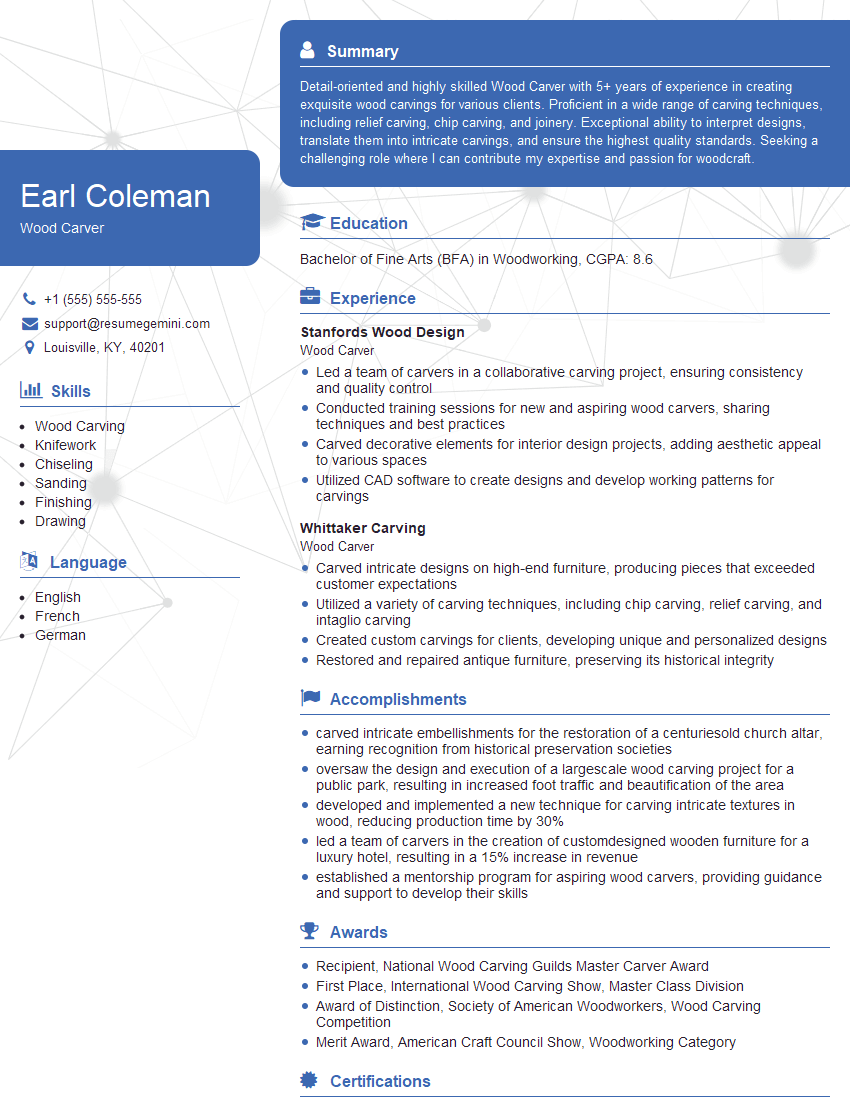The thought of an interview can be nerve-wracking, but the right preparation can make all the difference. Explore this comprehensive guide to Basic Knowledge of Sculpture interview questions and gain the confidence you need to showcase your abilities and secure the role.
Questions Asked in Basic Knowledge of Sculpture Interview
Q 1. What are the primary subtractive sculpting methods?
Subtractive sculpting, also known as carving, involves removing material from a larger block to reveal the desired form. Think of it like chipping away at a mountain to create a statue. The sculptor starts with a pre-existing mass and works by subtracting parts until the final piece emerges.
- Carving Stone: This is a classic subtractive method, where sculptors use chisels, mallets, and other tools to shape stone, marble, or wood. Michelangelo’s David is a prime example of masterful stone carving.
- Wood Carving: Similar to stone carving, but using different tools and techniques suited to the softer nature of wood. Intricate details are easier to achieve in wood than in stone.
The key challenge in subtractive sculpting is planning carefully. There’s no going back once material is removed, so a strong understanding of form and volume is crucial. Many sculptors create preliminary sketches and models to plan their carving process.
Q 2. Describe the additive sculpting process.
Additive sculpting is the opposite of subtractive; it involves building up a form by adding material layer by layer. Imagine building a sandcastle—you start with nothing and add sand grain by grain to create your masterpiece.
- Clay Modeling: This is the most common additive method. Sculptors work with pliable clay, adding, shaping, and smoothing it until the desired form is achieved. The flexibility of clay allows for corrections and alterations throughout the process.
- Wax Modeling: Often used in lost-wax casting, wax is sculpted into the desired form. This is ideal for intricate details and complex shapes that would be difficult to achieve with other materials.
- Welding: In metal sculpture, pieces of metal are welded together to build up the final form. This allows for the creation of complex three-dimensional structures.
Additive sculpting allows for greater flexibility and easier corrections compared to subtractive methods. However, it can be more time-consuming, especially with intricate details.
Q 3. Explain the difference between high-relief and low-relief sculpture.
Both high-relief and low-relief sculptures are types of relief sculpture, meaning the figures project from a background plane. The difference lies in how much they project.
- High-Relief: The figures project significantly from the background, often more than half their depth. They appear almost three-dimensional, with much of the figure detached from the background. Think of Roman busts or many medieval church carvings.
- Low-Relief (Bas-relief): The figures project only slightly from the background, often less than half their depth. They appear flatter and more integrated with the background plane. Many ancient Egyptian wall carvings are examples of low relief.
The choice between high-relief and low-relief depends on the desired effect and the limitations of the material. High-relief allows for greater dynamism and detail, while low-relief is better suited for larger, more expansive compositions.
Q 4. What are the common types of clay used in sculpture?
Many types of clay are used in sculpture, each with unique properties affecting workability and firing behavior.
- Earthenware Clay: A low-fire clay, relatively porous after firing. It’s easy to work with but requires careful handling during firing.
- Stoneware Clay: A high-fire clay, denser and more durable than earthenware. It holds detail well and is favored for functional and decorative pieces.
- Porcelain Clay: A very fine, high-fire clay known for its translucency and whiteness after firing. It’s demanding to work with, requiring skill and experience.
- Terracotta Clay: A type of earthenware known for its reddish-brown color after firing. It’s widely used for sculptures and pottery.
The choice of clay depends on the desired outcome, the sculptor’s skill level, and the firing capabilities available. Each clay type requires specific firing temperatures and techniques to achieve optimal results.
Q 5. What are the advantages and disadvantages of using bronze in sculpture?
Bronze is a popular material for sculpture, offering several advantages but also presenting some challenges.
- Advantages:
- Durability: Bronze is incredibly durable and resistant to weathering, ensuring the sculpture’s longevity.
- Detail: The lost-wax casting process allows for incredibly fine details to be captured.
- Aesthetic Appeal: Bronze has a rich, warm color and patina that adds to the artistic impact.
- Disadvantages:
- Cost: Bronze is an expensive material, requiring specialized equipment and techniques for casting.
- Complexity: The casting process is complex and requires expertise to execute successfully.
- Weight: Bronze sculptures can be very heavy, requiring careful handling and installation.
Despite the challenges, the advantages of bronze—its durability and ability to capture fine detail—make it a favored material for monumental and highly detailed sculptures.
Q 6. How do you prepare a clay sculpture for firing?
Preparing a clay sculpture for firing is crucial for preventing cracking and ensuring a successful outcome. The process involves several key steps:
- Drying: The sculpture is allowed to air dry slowly, ideally in a controlled environment to prevent rapid drying and cracking. This process can take days or even weeks depending on the size and thickness of the piece.
- Bisque Firing: The dried sculpture undergoes a low-temperature firing (typically around 1800°F or 982°C), called bisque firing. This process hardens the clay, making it more durable and preparing it for glazing or further firing.
- Glazing (Optional): If desired, the bisque-fired sculpture is glazed to add color, texture, and water resistance. Glazes are applied and then fired again at a higher temperature to fuse the glaze to the clay.
- High-Fire Firing (if applicable): Stoneware and porcelain clays require a high-fire firing (2200-2300°F or 1204-1260°C) to achieve their full strength and density. Earthenware, however, needs a lower temperature.
The specific temperatures and times for each firing will vary depending on the type of clay used and the kiln’s capabilities. Following the correct procedures is critical for achieving a well-fired, durable sculpture.
Q 7. Describe the process of creating a plaster mold.
Creating a plaster mold is essential for casting sculptures in materials like bronze or resin. The process generally involves these steps:
- Building the Mold: The sculpture is carefully prepared (often with a release agent) and sections of plaster are applied, creating a negative mold around the sculpture. Multiple sections are usually needed to remove the mold easily.
- Allowing to Cure: The plaster mold is allowed to fully cure and harden. This is crucial for the mold’s strength and integrity during the casting process.
- Removing the Sculpture: Once the plaster is fully cured, the sections of the mold are carefully separated, and the original sculpture is removed. The inside of the mold is now a negative impression of the original.
- Cleaning and Preparation: The mold is cleaned, inspected for any imperfections, and prepared for casting by sealing any cracks and smoothing rough edges.
Plaster molds are a versatile and relatively inexpensive method for creating multiples of a sculpture. Different types of plaster and mold-making techniques can be employed depending on the complexity of the sculpture and the desired level of detail.
Q 8. Explain the lost-wax casting process.
Lost-wax casting, also known as investment casting, is an ancient and precise method for creating metal sculptures. It’s a subtractive process, meaning we start with excess material and remove it to reveal the final form. Think of it like making a cake in a mold – you pour the batter (molten metal) into a cavity, let it set, then remove the mold to reveal the cake (sculpture).
Here’s a step-by-step breakdown:
- Creating the Wax Model: A wax model of the sculpture is meticulously crafted, often using tools like wax carving tools and a heat source to shape and smooth the wax.
- The Sprue and Runners: A sprue (a main channel) and runners (smaller channels) are attached to the wax model. These channels will allow molten metal to flow into the mold cavity.
- Investment: The wax model is carefully encased in a ceramic material called investment. This creates a sturdy mold that can withstand the high temperatures of molten metal.
- Burnout: The investment mold is heated in a kiln. This process melts and removes the wax, leaving behind a hollow cavity in the shape of the original wax model.
- Casting: Molten metal is carefully poured into the cavity through the sprue and runners.
- Cooling and Removal: Once the metal has cooled and solidified, the investment mold is broken away, revealing the finished metal sculpture.
- Finishing: The metal sculpture may require further finishing, such as cleaning, polishing, and chasing (removing excess metal or adding fine details).
Lost-wax casting allows for incredibly intricate details and is used to create everything from small jewelry pieces to large-scale bronze statues.
Q 9. What safety precautions should be taken when using power tools in sculpture?
Safety is paramount when using power tools in sculpture. A single lapse in attention can lead to serious injury. Here are some crucial precautions:
- Always wear appropriate safety gear: This includes safety glasses or a face shield, hearing protection, a dust mask (especially when working with stone or certain metals), and work gloves. Consider a respirator for particularly fine dust.
- Secure your workpiece: Use clamps or vises to firmly hold your material while working. Never try to hold a piece by hand while operating a power tool.
- Maintain sharp tools: Dull tools require more force and are more prone to slipping, increasing the risk of injury. Regular sharpening is essential.
- Use the right tool for the job: Don’t try to force a tool to perform a task it’s not designed for. Using the wrong tool can lead to breakage and accidents.
- Inspect your tools before each use: Check for any damage, loose parts, or frayed cords. Don’t use a tool if anything seems amiss.
- Be aware of your surroundings: Make sure the work area is clean, well-lit, and free of obstructions. Keep bystanders at a safe distance.
- Understand your tools: Read the manufacturer’s instructions carefully before operating any power tool. Take time to learn its capabilities and limitations.
- Disconnect power when not in use: Always unplug power tools when changing bits, cleaning, or taking a break. Never leave a running power tool unattended.
Remember, preventing accidents is far easier than dealing with the consequences. Prioritize safety at all times.
Q 10. How do you create armature for a large sculpture?
Creating an armature for a large sculpture is crucial for providing support and stability to the clay or other pliable material. The armature acts as the skeleton of the sculpture.
The process often involves:
- Planning the Structure: Begin with a clear understanding of the sculpture’s pose and proportions. Sketch it out and consider the stress points that need extra support.
- Choosing Materials: Common materials include steel rods, wire mesh (hardware cloth), and wooden dowels. The choice depends on the sculpture’s size, weight, and complexity.
- Constructing the Framework: Steel rods provide excellent strength for the main structure. Wire mesh is useful for creating larger forms and filling in gaps. Wooden dowels can add support for smaller, more delicate areas.
- Securing Joints: Use strong wire or metal fasteners to join different sections of the armature. Ensure it’s robust enough to withstand the weight of the clay or other material.
- Surface Preparation: The armature’s surface often needs to be textured to provide a better grip for the clay or modeling material. This can be achieved by wrapping it with burlap or chicken wire.
For example, a large equestrian statue might require a complex armature with strong steel rods for the horse’s legs and body, and wire mesh to form the musculature. The rider would have its own smaller armature, integrated with the horse’s.
Q 11. What are some common finishing techniques for sculptures?
Finishing techniques significantly impact a sculpture’s final appearance and longevity. They range from subtle enhancements to dramatic surface alterations.
- Polishing: This smooths the surface, revealing the material’s inherent luster (e.g., stone, metal). Techniques include hand-rubbing with abrasives or using power tools.
- Patination (for metals): This involves applying chemicals to create a surface finish, such as verdigris (green) on bronze or a darker tone on copper. It can dramatically alter the sculpture’s aesthetic and protect the metal.
- Waxing and Sealing (for stone and wood): This protects the material from environmental damage and enhances its color. Different waxes provide varying degrees of sheen.
- Painting and Gilding: Applying paint or gold leaf adds color, texture, and detail, often used to highlight specific elements.
- Sanding and Grinding: These techniques remove imperfections and create textures, particularly in stone and wood sculpture.
The choice of finishing technique depends heavily on the material, style, and intended effect of the sculpture.
Q 12. Describe different types of sculpting tools and their uses.
Sculpting tools vary greatly depending on the material and desired outcome. Here are a few examples:
- Chisels: Used for carving stone, wood, and other hard materials. Different chisels have various shapes and sizes for creating different effects (e.g., flat chisels for rough shaping, gouges for creating curves).
- Mallet: Used to strike chisels and other carving tools.
- Modeling Tools (for clay): These include loop tools (for removing clay), rib tools (for smoothing and texturing), and various shapers for adding details.
- Rasp and File: Used for refining and smoothing surfaces, particularly in wood and stone carving.
- Dental Picks: Fine tools for intricate detailing in small sculptures.
- Grinding Tools (powered): Angle grinders, rotary tools, and sanders can speed up shaping and smoothing, particularly for larger sculptures.
Selecting the right tool is vital for efficiency and safety. Understanding the characteristics of each tool will allow you to achieve precise and controlled results.
Q 13. What is the purpose of an undercutting in sculpture?
Undercutting in sculpture refers to the carving or modeling of recesses or undercut areas that are deeper than the surrounding surface, preventing the piece from being easily removed from a mold (e.g. lost-wax casting) or a block of material. Think of it like creating a lip or ledge that locks the piece in place.
The primary purpose of undercutting is often:
- Strengthening the sculpture: By creating interlocks, undercutting adds structural integrity, especially in delicate areas.
- Adding visual interest and depth: The shadows created by undercuts contribute to a sense of three-dimensionality and complexity, giving the piece a richer visual texture.
- Preventing breakage (during the casting process): In lost-wax casting, strategically placed undercuts help ensure the metal doesn’t shift or pull away from the mold during pouring and cooling.
Many ancient and contemporary sculptures incorporate undercutting to great effect, demonstrating its importance in both functionality and aesthetics.
Q 14. Explain the concept of ‘negative space’ in sculpture.
Negative space in sculpture refers to the empty areas surrounding or within a sculpture. It’s the space that isn’t occupied by the material of the sculpture itself, but which is just as crucial to the artwork’s overall composition and meaning.
Understanding and manipulating negative space is a vital skill for sculptors. It can be used to:
- Define Form: The shape of the sculpture is often as much defined by the negative space around it as by the positive mass.
- Create Balance: Carefully considered negative space can balance the visual weight of the sculpture.
- Add Tension and Movement: Strategically placed voids can create a sense of dynamism and flow.
- Enhance Meaning: The relationship between positive and negative space can be used to communicate ideas and emotions. For example, a large void might symbolize emptiness or loss, while smaller, controlled negative spaces could suggest precision and restraint.
Think of the negative space as a counterpoint to the solid form. The interaction between the two is what truly defines the sculpture’s visual impact and expressive power.
Q 15. How do you approach creating a life-size sculpture?
Creating a life-size sculpture is a meticulous process that requires careful planning and execution. It begins with a thorough understanding of the subject, whether it’s a person, animal, or abstract form. I typically start with a comprehensive series of sketches and studies to refine the pose and proportions. Then, I create a small-scale maquette, a miniature version of the sculpture, to test the design and make adjustments before committing to the full-scale work. For a life-size piece, I might use an armature – a supporting structure often made of metal or wood – to ensure the sculpture’s stability, especially in softer mediums like clay. The armature provides a framework onto which the clay or other material can be built up gradually, layer by layer, until the desired form is achieved. This process involves constant refinement, assessing proportions and details using various tools and techniques to achieve anatomical accuracy or artistic expression. Finally, the sculpture may require further processes such as casting in bronze or creating a mold for reproduction.
Career Expert Tips:
- Ace those interviews! Prepare effectively by reviewing the Top 50 Most Common Interview Questions on ResumeGemini.
- Navigate your job search with confidence! Explore a wide range of Career Tips on ResumeGemini. Learn about common challenges and recommendations to overcome them.
- Craft the perfect resume! Master the Art of Resume Writing with ResumeGemini’s guide. Showcase your unique qualifications and achievements effectively.
- Don’t miss out on holiday savings! Build your dream resume with ResumeGemini’s ATS optimized templates.
Q 16. What are some common challenges faced during the sculpting process?
Sculpting presents numerous challenges. One common issue is maintaining structural integrity, especially with larger pieces. Clay, for example, can crack or warp during drying. Another hurdle is achieving the desired level of detail and realism, which demands a high level of skill and patience. The process can be physically demanding, requiring long hours of work in often awkward positions. Working with different materials presents unique difficulties. Stone, for example, requires specialized tools and techniques to carve, and mistakes can be irreversible. Time constraints and budget limitations are also significant factors, potentially impacting the final product’s quality.
Q 17. How do you ensure the structural integrity of a sculpture?
Ensuring structural integrity is paramount. This is accomplished through several key strategies. Firstly, the choice of material plays a critical role. Materials like bronze are inherently strong, while materials like clay require careful construction and support. Armatures are crucial in many instances, providing an internal framework that prevents sagging or collapse. In clay sculpture, proper drying techniques are essential to avoid cracking. This often involves slow, controlled drying to prevent rapid shrinkage. For large-scale works, internal bracing or reinforcement might be incorporated. Once the sculpture is complete, a strong base or plinth is necessary to support the weight and prevent damage. In some cases, additional reinforcements might be added after the initial creation to improve durability.
Q 18. What are some examples of different sculptural forms?
Sculptural forms are diverse.
- In the round: Sculptures that are free-standing and can be viewed from all sides, like Michelangelo’s David.
- Relief: Sculptures where the figures project from a background plane, like many ancient Egyptian tomb carvings. These can be high relief (figures project significantly) or low relief (figures project only slightly).
- Environmental sculpture: Works that integrate with their surroundings, often on a large scale, such as land art installations.
- Kinetic sculpture: Sculptures with moving parts, often utilizing mechanics and engineering.
Q 19. Describe your experience with various sculpting mediums (e.g., clay, stone, wood).
I have extensive experience with various sculpting mediums. Clay offers a malleable and forgiving medium, perfect for initial modeling and detailed work. The ability to rework and refine is a key advantage. Stone, on the other hand, demands precision and skill, as mistakes are difficult to correct. I find the process of carving stone incredibly rewarding, though it’s physically demanding. Wood sculpting allows for unique expressive qualities, its grain and texture adding to the aesthetic. Each material presents its challenges and opportunities. For example, the way light interacts with the surface of a polished bronze sculpture differs dramatically from the way it interacts with the rough texture of a carved wooden piece. This affects how the finished work is perceived.
Q 20. How do you maintain and preserve your finished sculptures?
Maintaining and preserving finished sculptures is vital. The method varies depending on the material. Bronze sculptures often require periodic cleaning to remove accumulated dirt and pollutants. Stone sculptures are susceptible to weathering and erosion, necessitating regular inspections and treatments to prevent damage. Wood sculptures need protection from humidity and insects, potentially requiring the application of specialized sealants or preservatives. Proper storage, ideally in a climate-controlled environment, is critical for all materials. Regular monitoring for signs of deterioration is essential to ensure the longevity of the artwork.
Q 21. Explain your understanding of different artistic styles in sculpture.
My understanding of artistic styles in sculpture encompasses a broad historical perspective. From the classical ideals of ancient Greece and Rome, emphasizing balance and harmony, to the expressive power of Baroque sculpture, characterized by dynamism and emotional intensity. The rise of modernism brought about radical departures, with Cubism fragmenting forms and Abstract Expressionism exploring gesture and emotion. Minimalism championed simplicity and geometric forms. Contemporary sculpture showcases an even greater diversity of styles, integrating technology, performance art, and conceptual ideas. Each style reflects its historical and cultural context, contributing to the rich tapestry of sculptural expression.
Q 22. Describe your workflow when creating a sculpture from concept to completion.
My sculpting workflow is a meticulous process, much like building a house – you wouldn’t start with the roof! It begins with the concept phase, where I meticulously develop the initial idea through sketches, diagrams, and sometimes even digital modeling. This helps to solidify the form, proportions, and overall aesthetic before any material is touched. Next comes the preparatory phase – gathering materials, tools, and creating armatures or bases as needed. The sculpting phase itself involves building the form gradually, layer by layer, using various techniques like additive (adding clay) and subtractive (chiseling stone) methods. This is an iterative process; I constantly refine the form, ensuring it aligns with my vision. The finishing phase encompasses surface refinement, adding detail, and applying any finishes like patina or glaze. Finally, the presentation and documentation phase involves carefully preparing the sculpture for display, taking high-quality photographs, and creating a detailed record of the process.
- Example: For a life-size portrait bust, I’d begin with many detailed sketches of the subject’s face from various angles. Then I’d create an armature of wire and armature wire to ensure structural integrity before applying the clay.
Q 23. What are some influential sculptors and their works that have inspired you?
My work is deeply influenced by the masters. Michelangelo‘s mastery of human anatomy and the emotional depth he imbued into his marble sculptures, particularly David, has been a constant source of inspiration. His ability to capture movement and emotion within a static form is truly remarkable. I’m also greatly inspired by the fluidity and organic forms of Auguste Rodin, whose works like The Thinker explore the human condition with such raw power. His approach to capturing movement and texture is something I continually strive for. More contemporary artists like Barbara Hepworth, with her abstract forms and exploration of negative space, have also significantly influenced my understanding of sculptural possibilities.
Q 24. How do you translate a 2D sketch into a 3D sculpture?
Translating a 2D sketch into a 3D sculpture is like unfolding a map to build a terrain model. It requires a keen understanding of spatial relationships, perspective, and volume. I begin by carefully analyzing my 2D sketches, considering proportions and angles. I often create multiple sketches from different viewpoints to fully grasp the three-dimensional form. Then, I’ll utilize various techniques depending on the chosen material. For clay sculpting, I might create a rough armature based on the sketches and build up the form gradually, constantly referring back to my 2D references to ensure accuracy. If working with stone, I’d create a scaled-down maquette (model) from clay first to work out the form before transferring it to the final stone.
- Example: If I have a profile sketch of a bird, I’d need to consider the depth of its beak, the curve of its wings and body, creating a sense of three-dimensionality from that single view, often using additional sketches to fill the gaps.
Q 25. How do you handle mistakes or imperfections during the sculpting process?
Mistakes are inevitable in sculpting, a bit like a painter accidentally applying the wrong color. My approach is to view them as opportunities for learning and refinement. In clay, I can easily rework mistakes by adding or removing material. If it’s a significant error, I might start over on a section, or even the entire piece, depending on its severity. With more permanent materials like stone, correcting mistakes is significantly more challenging, demanding patience and careful planning. Sometimes, I use the mistake to inform the final form, integrating it into the overall design. This adds a unique and unpredictable element to the finished piece. The key is not to panic, but to calmly assess the situation and choose the best corrective action.
Q 26. Describe your problem-solving skills in relation to sculpting challenges.
Problem-solving is integral to sculpting. It’s a continuous process of overcoming challenges. For instance, if I’m struggling to capture a specific anatomical feature accurately, I might consult anatomical references, study photographs, or even seek feedback from fellow artists. If the material itself is proving difficult to work with, I might adjust my techniques, tools, or even switch materials entirely. A flexible approach and the ability to experiment are crucial. I always break down complex challenges into smaller, more manageable steps, focusing on one aspect of the sculpture at a time. This method allows for better focus and helps avoid getting overwhelmed.
Q 27. What is your experience with different types of finishes (e.g., patinas, glazes)?
My experience with different finishes is quite extensive. Patinas, which are essentially chemical treatments, add color and depth to metal sculptures, creating a range of effects from antique bronze to vibrant greens. I’ve used various patinas to achieve specific aesthetic goals, sometimes combining multiple techniques for a unique look. Glazes, on the other hand, are used on ceramic or earthenware sculptures to add a protective layer and enhance their surface texture and color. I have experimented with both matte and glossy glazes, achieving everything from a smooth, almost glassy finish to a textured, rustic appearance. The choice of finish significantly impacts the overall aesthetic of the piece, and I carefully select it based on the material and the desired effect.
Q 28. How do you ensure your work meets the client’s vision and specifications?
Ensuring my work aligns with a client’s vision is paramount. I begin by engaging in extensive discussions with them, understanding their preferences, budget, and expectations. This often involves reviewing reference images, discussing desired styles, and establishing a clear timeline. Throughout the sculpting process, I regularly share progress updates with the client – photographs, videos, and even in-person reviews, ensuring they are actively involved in the creative process. This collaborative approach allows for timely feedback and avoids misinterpretations, ultimately leading to a finished piece that exceeds their expectations. Clear communication and proactive collaboration are key to client satisfaction.
Key Topics to Learn for Your Basic Knowledge of Sculpture Interview
- Materials and Techniques: Understanding various sculpting materials (clay, stone, wood, metal, etc.) and their properties. Explore different techniques like modeling, carving, casting, and assembling. Consider the advantages and disadvantages of each approach for different artistic expressions.
- Form and Composition: Grasping fundamental principles of three-dimensional form, including mass, volume, space, and negative space. Analyze how these elements contribute to the overall composition and aesthetic impact of a sculpture. Practice analyzing existing works to understand these principles in action.
- Sculpture History and Movements: Familiarize yourself with significant periods and movements in sculpture history (e.g., Ancient Greek, Renaissance, Modern, Contemporary). Understanding the historical context helps to analyze and appreciate different stylistic approaches and influences.
- Artistic Concepts and Theories: Explore theoretical frameworks relevant to sculpture, such as aesthetics, art criticism, and the role of sculpture in society. Be prepared to discuss your understanding of artistic intention and the communication of ideas through sculptural form.
- Process and Problem-Solving: Discuss your approach to the sculpting process, from initial concept to final execution. Be ready to articulate how you overcome challenges in material handling, technical execution, and achieving your artistic vision.
- Studio Practices and Safety: Demonstrate an understanding of safe studio practices and the responsible use of tools and materials. This includes health and safety regulations related to specific materials.
Next Steps
Mastering the basic knowledge of sculpture is crucial for career advancement in the arts. A strong understanding of materials, techniques, and artistic concepts demonstrates your dedication and expertise. To significantly boost your job prospects, crafting a compelling and ATS-friendly resume is paramount. This is where ResumeGemini can help! ResumeGemini provides a powerful platform to create a professional resume tailored to showcase your specific skills and experience. We offer examples of resumes specifically designed for candidates with a Basic Knowledge of Sculpture, helping you present your qualifications effectively to potential employers. Invest time in creating a strong resume – it’s your first impression.
Explore more articles
Users Rating of Our Blogs
Share Your Experience
We value your feedback! Please rate our content and share your thoughts (optional).
What Readers Say About Our Blog
Hi, I’m Jay, we have a few potential clients that are interested in your services, thought you might be a good fit. I’d love to talk about the details, when do you have time to talk?
Best,
Jay
Founder | CEO
